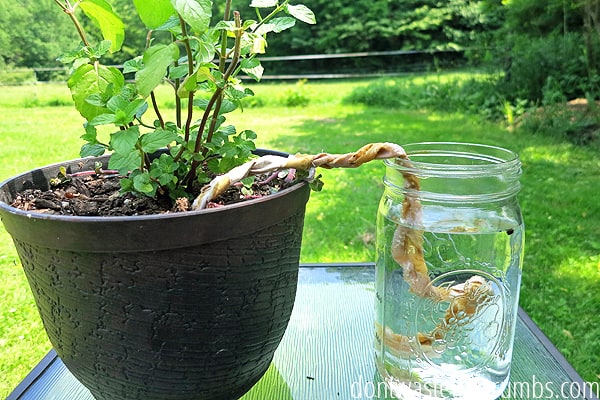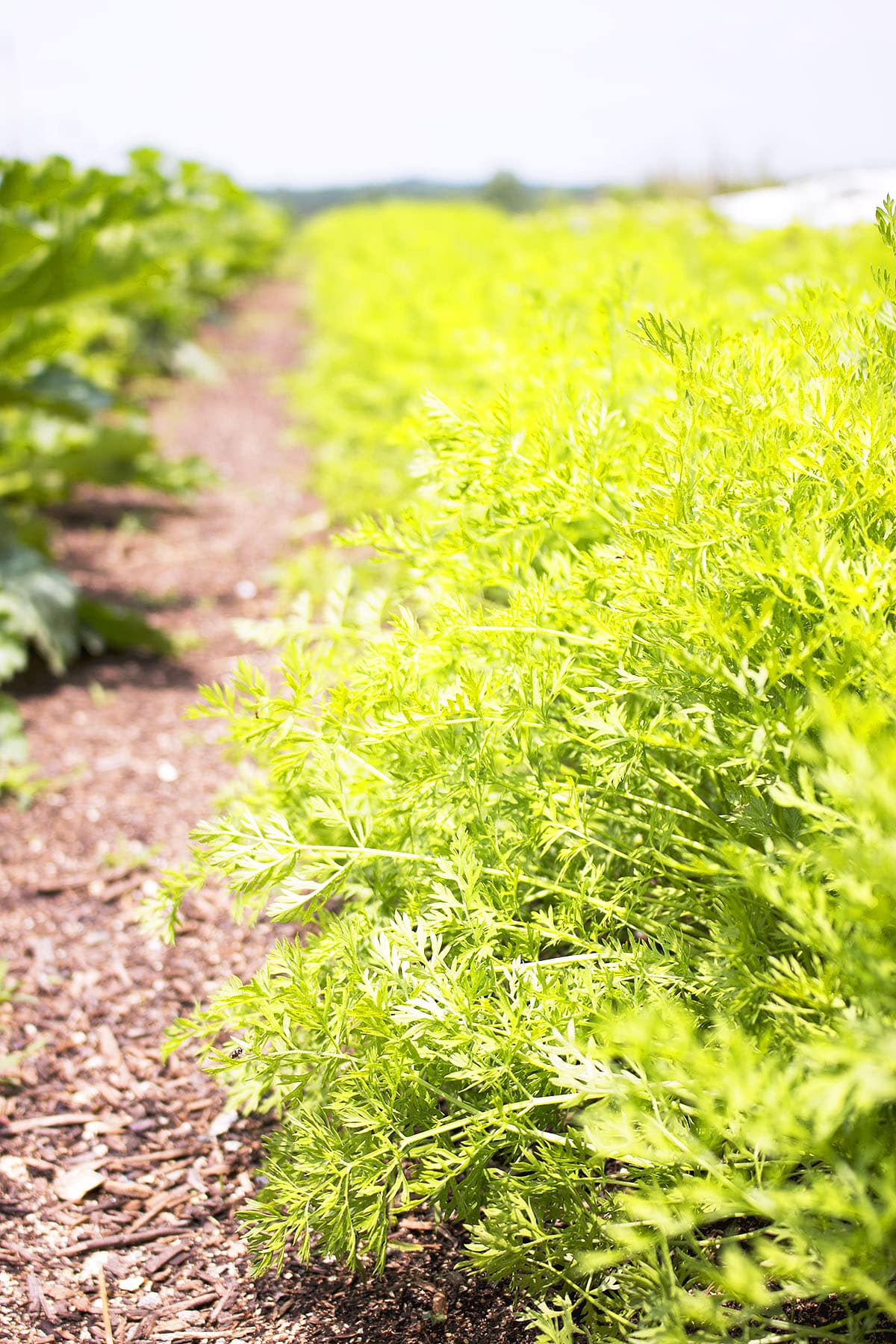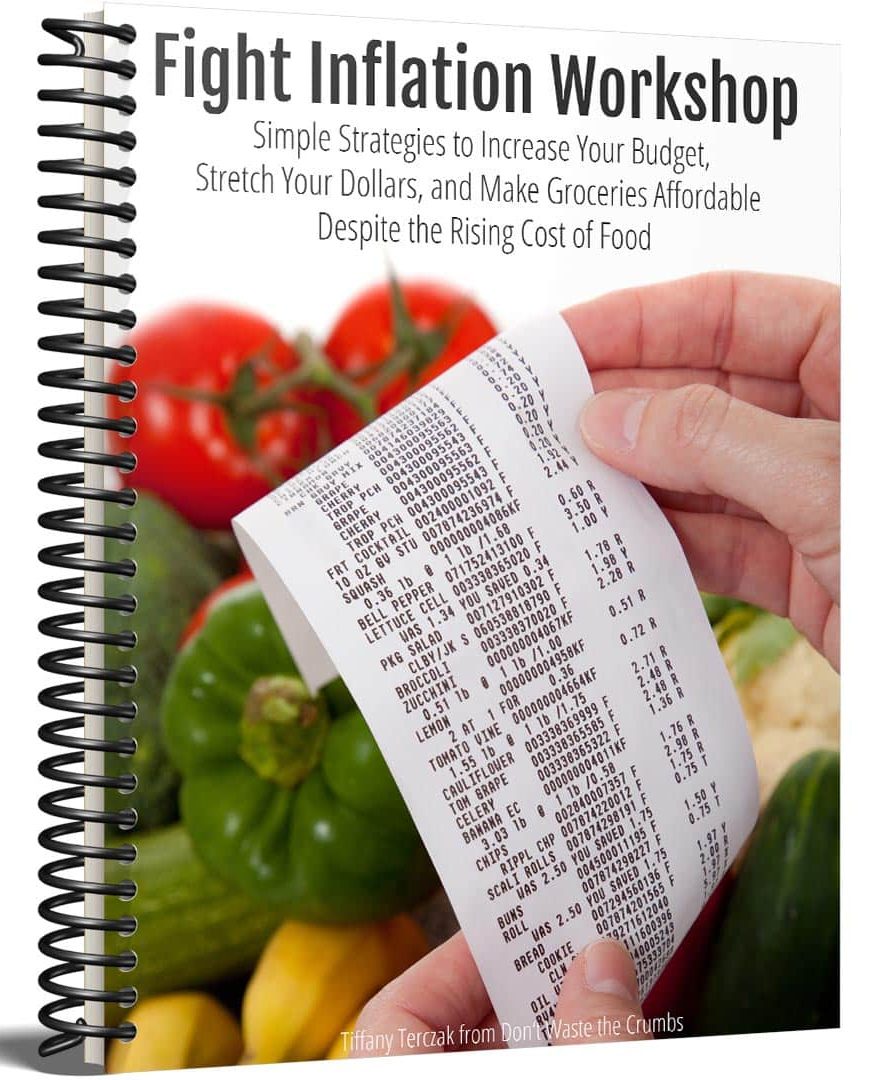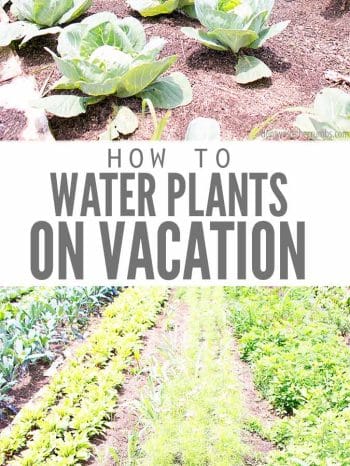Are your bags packed, and ready for a vacation? Learn how to water plants while away! You won’t need to worry about your garden with these low-maintenance ways to self-water your plants.

My family loves to travel. We also love to have a garden. And we also don’t want to spend thousands of dollars on a self-timed irrigation system.
So, we have several ways to water our plants while away!
These methods are frugal, use materials we already have at home, and keep plants alive while we’re going away on vacation.
It’s a total win-win!
How to Water Plants While Away
I have three tried-and-true methods I’ve personally used for watering plants while on vacation. These three methods are super simple and can be used for watering both indoor and outdoor plants!

METHOD #1: DIY Water Wick
This is a self-watering system for potted plants. It’s a simple method you can use by taking any fabric you have lying around. I’ve used old T-shirts, which work just fine, but if you want something a little prettier, you can use craft fabric like I did.
This DIY Water Wicking setup works by sucking the water from the jar up the braided fabric and into the dry soil. It keeps the plants hydrated as it adds water to the soil.
Tools Needed
- Cotton fabric (twine or rope work as well)
- Large mason jar (or another water container)
DIY Water Wick METHOD
- Cut three strips of fabric.
- Braid them together and tie a knot on both ends.
- Stick one end of the cotton rope braid into the soil at the base of the plant and the other end into the jar of water. Make sure the braid is just long enough to reach from the base of your plant to the bottom of the jar (or coil the extra in the bottom of the jar).
Plant Self-Watering Tip: If the braid is in hot direct sunlight, it will dry out before the water reaches the plant. Therefore, it’s best to put your containers in a partly sunny location while you’re away so they get enough sun but not too much. This will also help them stay moist, so they won’t need as much water.

METHOD #2: DIY Plant Watering Bottle
This one is great for in-ground or raised bed gardens but can also be used for container gardens. Clear plastic water bottles or soda bottles work wonders as a DIY drip system.
Tools Needed
- An empty 1 or 2-liter plastic bottle for every 4-6 sq ft of the garden (depending on the plants)
- A drill or awl

DIY Plant Watering Bottle METHOD
- Cut the bottom of the bottle off.
- Then drill a few drainage holes in the bottle cap and screw the cap back on.
- Bury the neck of the bottle in the ground close to your plants and fill the bottle with water. The water will slowly drip out over a few days or a week, depending on how big your bottle is.

DIY Plant Waterer Tip: You may want to cover the top of the bottle waterer to avoid evaporation or mosquitoes. I’ve used plastic wrap, a clear plastic bag, or the end that I cut off, upside down and weighted with rocks.
METHOD #3: DIY GLASS BOTTLE PLANT WATERER
These waterers are great for any garden. Since the bottle is glass and not plastic, water only goes out as the air comes in. That means if the ground is saturated with water, little, if any, water will come out of the bottle. It’s a great way to make sure your plants will have the right amount of water.
Tools Needed
- A glass bottle, like a wine bottle, for every 4-6 sq ft of the garden (more, if using a smaller bottle like a beer bottle)
DIY WINE BOTTLE WICKING PLANT WATERER METHOD
- Fill the empty bottle with water.
- Stick the neck several inches into the ground near the base of each plant or between plants.
Another option for your container plants is to move them to a shadier spot. A little indirect sunlight for a week won’t hurt them and will keep them from drying out too much. You can move them to a covered porch or put up a patio umbrella. Another good idea is to set up an umbrella or canopy tent over your in-ground garden too!

Watering Indoor Plants on Vacation
Keeping plants watered indoors is similar. Moving plants from direct sunlight in the windows will help them from drying out. You can keep your houseplants watered using the bottle method or create a mini greenhouse with a plastic bag over the plants.
I’ve also seen some tutorials on using the bathtub for the plants. Place the plants in the tub or sink and turn on the water to a very slow drip. This keeps the plants watered, with proper drainage, in a relatively safe place in the bathroom.

Benefits of Using Self-Watering Planters
- Using self-watering planters provides a consistent water flow to your plants without daily watering. The slow-drip system allows your plants to get an adequate water supply without over or under-watering them!
- When plants experience periods of inconsistent or inadequate water supply, they can get stressed. So, by using these self-watering methods, you can help your plants not feel stressed or risk dehydration while you’re away!
- You don’t need to depend on a plant sitter to water your plants while away, which may save you a bit of extra cash!
- You can prevent root rot because these self-watering planters provide the perfect amount of water for your plants! This prevents too much water from getting into the soil and roots, which can lead to rot.
- Self-watering pots require less frequent watering and monitoring compared to traditional planters. This is super beneficial for people with busy schedules or those who travel frequently and don’t have the time for daily watering!
Pro Tips for Preparing Your Garden For Plant Self-Watering
1. Carefully inspect the garden before you leave.
Catch pest problems early so your garden beds can be in optimal health before you leave. You will be more likely to come home to a healthy garden if minor pest issues are taken care of before you go. I like to use this homemade organic pest control spray to treat pest problems. Because it’s safe and non-toxic, it can be used as prevention too.
2. Mulch your plants.
Mulching helps retain water and keep weeds away. Just be sure to use vegetable garden-friendly mulch. I like leaf compost or grass clippings because they are free, easy to find, and can add nutrients to your soil.
3. Have a watering plan.
Water is one of the biggest concerns for your garden while you’re away. Give your garden a good soaking with the hose for about 20 minutes each evening for 2-3 days before you leave. If you have an in-ground garden or raised beds, this will be enough to get your plants through about a week of dry weather.
If you’re going to be gone on a longer trip, you have containers as part of your garden, or you live in a particularly dry and arid location, you will want to consider an automatic watering system. You can invest in a timed sprinkler system which could be helpful beyond the vacation. But that means leaving the water spigot on and risking a leak. Fortunately, there are inexpensive (even free) ways to create a drip irrigation system in your garden or containers.
4. Do a test run before you leave.
Before you go on your vacation, maybe a week before, test out one of these methods to make sure they work before you leave. This way, you can prevent any mishaps from happening!

FAQs on How to Water Plants While Away
How long can plants survive without water?
It depends on the type of plants you have! For example, drought-tolerant plants like succulents, can go one to two weeks without water. However, outdoor potted plants and garden plants may need more watering, as much as three times per week. Indoor plants may need watering twice a week, depending on the species.
Pot size also plays a role in how often you should water your plants! The larger the pot, the more excess water it can hold, meaning they don’t need to be watered as often. The opposite is true for small pots.
So, it’s important to choose the right self-watering method so you can keep your plants as happy and healthy as possible.

Watering Plants While On Vacation
Going on vacation doesn’t mean your poor plants have to suffer! With these simple DIY watering methods, you can actually enjoy your vacation knowing that your plants are getting the right amount of hydration they need to thrive, even when you’re not there. So, next time you embark on a vacation or find yourself away from home, put these tips and strategies into action to ensure your plants remain lush and vibrant!
More Gardening Tips Tricks
- Composting for Beginners
- DIY Raised Beds
- How to Save Money Gardening
- Starting a Frugal Urban Garden
- Ways to Use Plastic for Gardening








Do you have to cut the plastic bottle off bottom. Can u fill it with water and drill hole in cap then insert in dirt in garden? What’s the reason for cutting off bottom? Just curious . Thanks
Mary
It might not help with mosquitoes, but putting small plants in a couple inches of water, say in a storage tub, can hold them over for an few days to a week.
Thanks for the idea Jenne!
So timely as we’re going on vacation soon AND I just saw aphids on my tomato plants. Gonna check out that pest spray, thanks!
As a novice gardener these watering ideas are wonderful – thank u so much!
Living in Colorado, our gardens dry out very quickly, and we have to plan for watering far in advance, at the time of planting. I’ve frequently used the bottle method, but in a different way. You can use anything from small pint-size bottles for small containers or pots, to larger soda bottles for larger containers, and I will be using several 2-liter soda bottles or even gallon-size water jugs for this year’s raised beds. You need a heavy sewing needle, small awl, or thin ice pick. The larger the hole, the faster the water will run out, but also, you stand less chance of it getting clogged up with dirt. Poke many small holes around the bottle, below the neck. Bury the bottle *right-side-up* to the neck at the time you fill your pot or container with potting soil. If transplanting seedlings or small plants, work them in around the bottle. For raised beds, evenly space several larger bottles or jugs, again, *right-side-up* throughout the bed as you fill it with your desired garden soil. Its okay if they aren’t buried all the way up to the neck: this may actually help you find the bottles as your garden grows and fills with beautiful thick plants. Keeping the lid on eliminates evaporation and mosquitoes. Water the containers and garden beds as usual, but also fill up the bottles at the same time. Then there’s less need to come back tomorrow (or even the same day, here in Colorado) to water again. This also encourages the plants to root deep to go after all that yummy water lower down in the soil.
Great ideas, thanks for sharing!
do you need to cut out the plastic bottle?
Nope. You can use it like the glass bottle 🙂
I plan on trying a new method this year, planting directly into cheap, reusable shopping bags, and setting them into a plastic wading pool…you simply fill the wading pool with a few inches of water, and your plants should be all set.
Cool idea!
Interesting idea! Please do let us know how this turns out!
I froze bottles of water and drilled holes in the bottoms. This way it took more time for the water to melt and therefore did not drain out as fast as it otherwise did. If you want to reuse the bottle now that they have holes you can stand them up in a container bucket etc and freeze in chest freezer if you have room.
Great idea! thanks for sharing.
Great tip Beverly – thanks for sharing!
My favorite method is a good neighbor! We keep an eye on their place while they are gone. In exchange, they watch ours. They pick produce that needs harvested (keeping it, of course!), and water it as needed. I leave the hose hooked up to the irrigation lines for my convenience and theirs.
It’s so wonderful to have neighbors that can help you out. That’s definitely the best way to have a relaxing vacation!